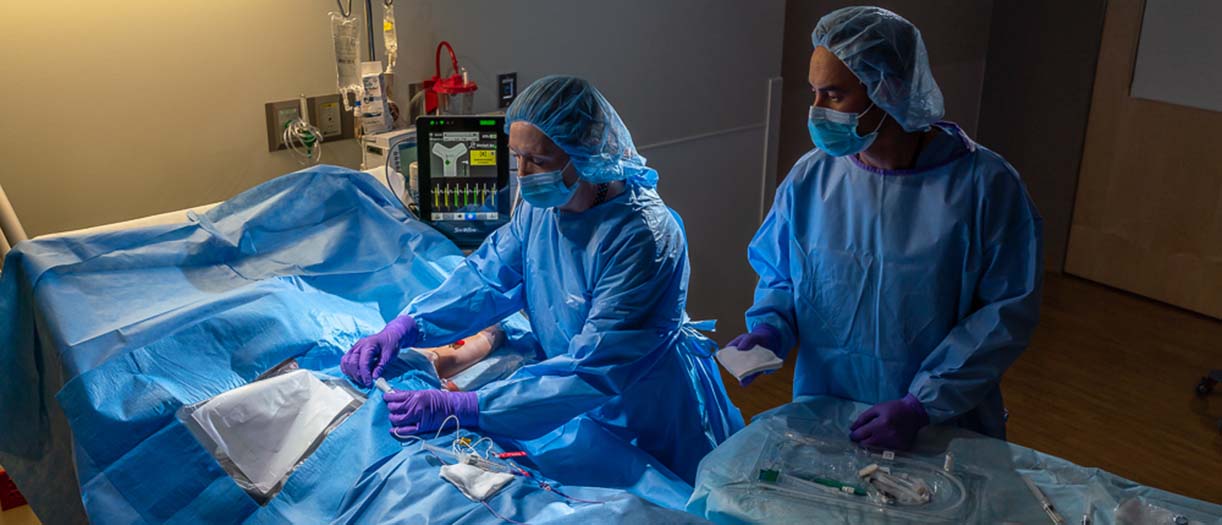NIVAS white paper: The benefits of a vascular access team
Over a billion peripheral intravenous catheters (PIVCs) are used globally every year, yet 35-50% of them do not meet their intended dwell time, resulting in complications which can cause treatment delays and even patient discharge.1,2
The National Infusion and Vascular Access Society (NIVAS) of the United Kingdom recently released a white paper, authored by NIVAS Chair Andrew Barton, advocating the benefits of vascular access teams (VATs) across the UK NHS with the goal of reducing PIVC-related complications.
The risks of vascular access without a VAT
According to NIVAS, PIVC failures are common, especially in patients with a lack of visual or palpable apparent veins or in patients with a known history of difficult intravenous access (DIVA).3 If no formal vascular access team exists, NIVAS explains that patients are often passed between various staff teams including consultant radiologists and anaesthetists, resulting in up to 15 venous access attempts a day.3
The Royal College of Radiologists reported the situation of staff shortages within the NHS “remains dire,” and that radiology departments may be worried about the demands for vascular access and its impact on timely patient care.4
Repeated attempts at PIVC placement without a VAT can lead to long delays in patients receiving IV therapy, missed doses and suboptimum treatment with alternative oral therapies resulting in increased length of stay and poor clinical outcomes.3 Other vascular access complications can include phlebitis, infiltration, occlusion, catheter dislodgement and healthcare-associated infection (HAI), all of which can be reduced by the implementation of a vascular access team.3,5 More specifically, catheter-related bloodstream infections (CRBSIs) account for up to 20% of all HAI cases in the UK, and are considered one of the most frequent, costly and potentially life-threatening complications of central venous catheterisation.6
Phlebitis is the most common complication, and one study identified a direct link between increased phlebitis rates and multiple cannulation attempts.5
How VATs can facilitate vascular access
NIVAS claims that dedicated VATs can minimise treatment delays, reduce infection and complication rates, boost patient experience and reduce length of stay.3
In fact, by reducing central line associated bloodstream infections (CLABSIs) alone, VATs can help decrease expenses and increase efficiency, quality of care, patient satisfaction and improve patient outcomes.3
The benefits of VATs are becoming widely acknowledged across Europe when compared to the risks and costs of complications. A European faculty of multidisciplinary VAT leads and experts found that the implementation of a VAT can positively impact patient safety and satisfaction, improve organisational efficiencies and cost-effectiveness.7
To be successful and cost effective, the white paper states that VATs should be “multifunctional and provide services to all clinical areas and service users” to take on most of the vascular access work and therefore potentially relieve pressures on other departments and specialists.3
The primary function of a VAT is to ensure that the patient gets the most appropriate device for their treatment, yet they are also relied on “to assess, insert, manage, perform surveillance, analyse their service data, solve clinical concerns and where possible remove vascular access devices.”8 VATs can also implement training programmes to improve knowledge and compliance with standardised care bundles.3
VATs: A patient’s vascular access journey
NIVAS highlights the story of Jane, a patient who has lived with short bowel syndrome and IV nutrition for the past 15 years.
One year after the placement of her first Hickman line, she experienced her first infection. “This was made worse by the doctors and nurses trying up to 10 times to get a cannula in my hand,” Jane states in the white paper.3 This was the first of four or five Hickman lines, and so many peripherally inserted central catheters (PICCs) “that I lost count.”3
Today, Jane is left with the fear of returning to hospital. Because of the trauma to her veins, she is unable to receive any more Hickman lines. “They tell me this is my last catheter, which is scary, and even more so because I have found myself needing more frequent visits to the hospital with overnight stays.”3 She concludes by saying that she wishes she could have the same level of vascular access expertise at every hospital she visits, and that having a VAT “makes such a big difference to my experience and peace of mind.”3
To learn more about the benefits of VASTs and the importance of expert vascular access care, read the full NIVAS white paper here.
References
- Alexandrou E, Ray-Barruel G, Carr PJ, Frost S, Inwood S, Higgins N. International prevalence of the use of peripheral intravenous catheters. Journal of Hospital Medicine. 2015 Aug;10(8):530-3. doi: 10.1002/jhm.2389.
- Helm RE, Klausner JD, Klemperer JD, Flint LM, Huang E. (2015) Accepted but unacceptable: peripheral IV catheter failure. Infusion Nurses Society. May-Jun 2015;38(3):189-203. doi: 10.1097/NAN.0000000000000100.
- National Infusion and Vascular Access Society (NIVAS). The Benefits of a Nursing Led Vascular Access Service Team. Published June 2022. Accessed July 12, 2022 at: https://nivas.org.uk/contentimages/main/NIVAS-White-paper-for-standardisation-of-vascular-access-teams-within-the-NHS_FINAL-27.06.22.pdf
- The Royal College of Radiologists (RCR). Clinical radiology UK workforce census report 2020. Accessed on 17 July 2022 at: https://www.rcr.ac.uk/system/files/publication/field_publication_files/clinical-radiology-uk-workforce-census-2020-report.pdf.
- Simin D, Milutinović D, Turkulov V, Brkić S. Incidence, severity and risk factors of peripheral intravenous cannula‐induced complications: An observational prospective study. Journal of clinical nursing. 2019 May;28(9-10):1585-1599. doi: 10.1111/jocn.14760.
- Gahlot R, Nigam C, Kumar V, Yadav G, Anupurba S. Catheter-related bloodstream infections. Int J Crit Illn Inj Sci. 2014 Apr-Jun; 4(2): 162–167. doi: 10.4103/2229-5151.134184
- Mussa B, Pinelli F, Cortés Rey N et al. Qualitative interviews and supporting evidence to identify the positive impacts of multidisciplinary vascular access teams. Hospital Practice. 2021 Aug;49(3):141-150. doi: 10.1080/21548331.2021.1909897.
- Carr PJ, Moureau NL. Specialized Vascular Access Teams. Vessel Health and Preservation: The Right Approah for Vascular Access. 2019. Doi:10.1007/978-3-030-03149-7.
BD and the BD logo are trademarks of Becton, Dickinson and Company or its affiliates. All other trademarks are property of their respective owners. ©2022 BD. All rights reserved. BD-68778
The views and opinions expressed in this presentation are solely those of the interviewee and do not necessarily reflect the view, official policy or position of Becton, Dickinson and Company.




